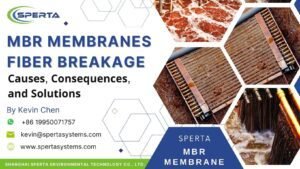The MBR (membrane bio-reactor) is widely used in water treatment, such as water reuse, dispersion trThe MBR (membrane bio-reactor) is widely used in water treatment, such as reuse, dispersion treatment, and updated sewage emission. Compared with the traditional water treatment method. The advantages of MBR are obviously – supports a higher load, longer SRT, higher-efficiency interception & so on…
However, there are some misunderstandings in the MBR application.
Misunderstanding 1: Bigger flux is better.
Not true. The membrane material and structure determine the flux of the membrane. There is a maximum limit to the porosity rate and flux. Filtration is essentially a physical process. The membrane material must sacrifice the flux while reducing the pore size and need to balance the strength and ensure long-term operation. So, those reason leads to constant flux. Therefore, in the design and application process, the design should be based on the recommended parameters from the manufacturer.
Misunderstanding 2: The water quality will be 100% guaranteed if we use the MBR.
The MBR process combines the activated sludge and membrane filtration, replacing the secondary settling tank with membrane filtration based on the traditional activated sludge process.
The MBR process brings advantages, such as high sludge concentration. But this doesn’t mean that the MBR process can deal with all problems. For removing pollutants, membrane filtration has a pronounced effect on SS. But the removal of organic matter still depends on the biodegradability of activated sludge and organic matter. MBR has a limited impact on the biodegradable sewage or the previous treatment, which is not so good or does not meet the standard.
Misunderstanding 3: The MBR process doesn’t need to dispose of the sludge.
Due to the excellent retention effect of MBR, the activated sludge in the MBR process can reach a higher concentration, achieving the separation of HRT and SRT without considering the influence of sludge concentration on the effluent. However, this advantage only enhances the space for biochemistry. It does not affect the product water. But it couldn’t support it. The problem of that should be returned to the activated sludge. If the sludge is not disposed of, the activated sludge will have many issues, affecting the biochemical performance and the aeration. The MBR process in the project can indeed reduce sludge discharge, but it does not mean non-discharge.

Misunderstanding 4: Decrease the sludge concentration to prevent the membrane from getting polluted.
Not true. Plugging is a common problem in MBR applications, especially when there is a high sludge concentration. So, a misunderstanding reduces the sludge concentration to avoid being polluted. The low concentrations and high sludge concentrations can cause the membrane to be fouled quickly. The correct way is to keep the attention within a suitable range. In addition, we should also maintain the effect of aeration on the surface of the scouring membrane at the corresponding holding amount.
Misunderstanding 5: The membrane determines the quality of product water.
The principle of the membrane is filtration. It is a physical process. SS is the primary pollutant in removing. Its significance for MBR is to improve biochemical performance, but it can’t filter soluble organic matter. So it isn’t responsible for COD and other indicators. The removal of organic matter still depends on the design and operation management of the entire process chain.








